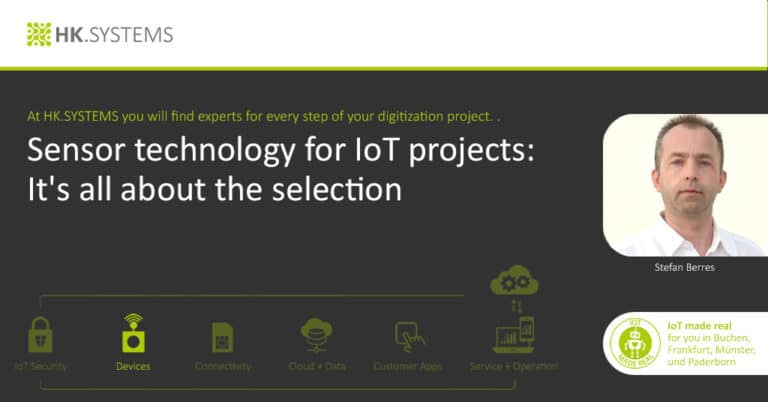Internet of Things (IoT), Industrial Internet of Things (IIoT), Industry 4.0, Digital Factory: These megatrends are inconceivable without one important detail – the right sensor technology. As interfaces to the outside world, sensors make forward-looking IoT applications possible in the first place. Modern industrial plants? Smart home? Mobility of the future? Simply not feasible without the right sensor technology. Because the right sensors play an often inconspicuous but all the more important role: they collect data and information that is then analyzed. This is the basic prerequisite for products, services and entire industrial sectors to become smart, intelligent and digital. Or to put it even more clearly: sensor technology is the basis for successful IoT projects. At HK.SYSTEMS, our sensor specialists ensure the right sensor selection, the rapid implementation of sensor technology, and the sensible adaptation of sensor data.
The technology: This is how sensors work
Sensors measure various physical or chemical properties. A sensor is – simply explained – a technical component that records a measured value in its actual state at a suitable measuring position. This data is then passed on to a data processing system. The sensor thus forms the interface between the data processing system and the outside world of a complete application system. A sensor is normally part of a control loop. If an actual value deviates too much from a target value, it takes measures independently: Compensation, alarm or even shutdown. In our everyday lives, we are now constantly surrounded by sensors: in smoke detectors, in automatic doors, in automobiles, in smartphones, and so on.
The great variety: Different types of sensors
There is a suitable sensor for just about every physical condition:
- Force measurement: strain sensors, weight force sensors.
- Volume: filling level
- Light: luminous intensity, image sharpness, opacity
- Speed: rotational speed, airspeed, acceleration
- Magnetism: proximity sensors
- Electromagnetism: location of radio signals
- Acoustics: sound sensors
- Position: inclination, position
- Climate: humidity, pressure, temperature
Our proprietary portfolio covered by our technology network can be used for application areas: Printed Electronics, customized or standardized sensor solutions, patented Sensofoil® sensors, foil potentiometer technology and sensor elements, SensoForce pressure sensors (FSR technology) and in-mold electronics.
The search for the right sensor: selection follows intended use
The special "IoT sensor" does not exist. After all, in principle, all sensor types can be connected to the cloud to analyze collected data. So the crucial question is: Which sensors do I need for which IoT applications? The biggest challenge in the choice is always the complexity of the overall system and the sensitivity of the individual sensors: The more measured values have to be processed in a central system, the more demanding and important this step is. This is because the sensors act as interfaces to the outside world. Their direct contact with other assemblies, outside air, weather or other physical variables also always contributes to their wear and tear. Therefore, when selecting the appropriate sensor technology, it is essential to also keep in mind the necessary monitoring and the expected replacement of sensitive components. Especially in the area of the Industrial Internet of Things (IIoT), it often depends on the harsh operating environment which sensors are able to reliably fulfill their function for years, preferably without much maintenance. For production lines and industrial plants, for example, only industrial-grade, robust sensor designs make the short list. Environmental conditions such as dust, dirt, oil, humidity and temperature also have a major influence, as does connectivity, i.e. the interface to higher-level systems. The connectivity properties of the sensors should not only match the data volume, but also the existing system infrastructure.
Conclusion: Successful IoT and IIoT projects through suitable sensor technology
The right choice of sensor in the context of an IoT project always depends on the planned individual area of application: sometimes it is sensors with the lowest possible power consumption in order to achieve the longest possible service life. Then again, it’s a matter of short-term availability and a long-term replacement option for the components and devices involved, depending on scaling in large quantities or in very small quantities. With our experience, we take this search off each customer’s hands and find the right sensor technology for them. In our partner network, we combine the know-how we have accumulated over decades and act as a general contractor for our customers, supplying all the necessary services from a single source without complications: From sensor selection to suitable I/O and control systems to the required cloud connections and the necessary network technology.
Stefan Berres from our partner company Hoffmann + Krippner is our expert for additive manufacturing. If you have any questions, he will be happy to answer them:
